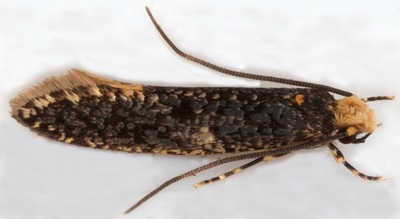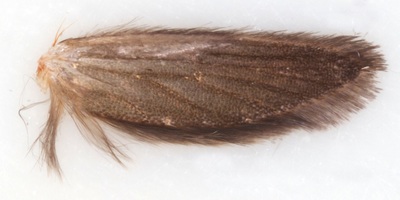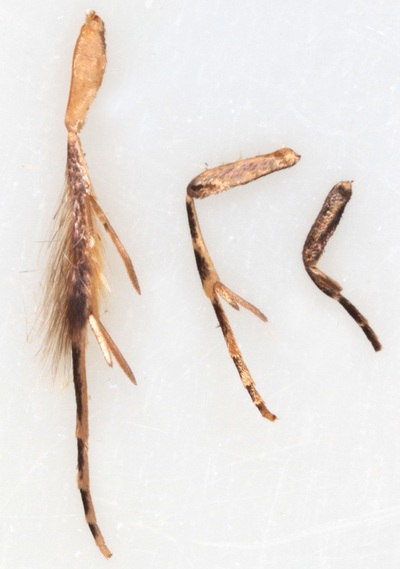12.036 Monopis laevigella (Skin Moth)
ws:13-20mm; May-Sep; common throughout UK
ID: M.weaverella is said to be most easily distinguished from M.laevigella by having a large pale tornal spot (MBGBI2)
However, M.laevigella sometimes has a pale tornal spot. Further features given for separation of these two species are:
1) Position of the pale hyaline spot at .4 from base to apex of forewing in M.laevigella and .45 in M.weaverella.
2) Irroration with transparrent whitish scales more marked in M.laevigella.
3) More striking contrast between darker wing and pale cilia in M.weaverella.
Male genitalia
Male genitalia 4) Gnathos has a blunter tip in M.weaverella. 5) Valvae more elongate in M.weaverella. 6) Saccus longer in M.laevigella.
Saccus:valva ratio 1.4-1.7 for M.laevigella, 1.0-1.2 for M.weaverella. 4) Tip of gnathos blunter in M.weaverella.
See Monopis for more detail
However, M.laevigella sometimes has a pale tornal spot. Further features given for separation of these two species are:
1) Position of the pale hyaline spot at .4 from base to apex of forewing in M.laevigella and .45 in M.weaverella.
2) Irroration with transparrent whitish scales more marked in M.laevigella.
3) More striking contrast between darker wing and pale cilia in M.weaverella.
Male genitalia
Male genitalia 4) Gnathos has a blunter tip in M.weaverella. 5) Valvae more elongate in M.weaverella. 6) Saccus longer in M.laevigella.
Saccus:valva ratio 1.4-1.7 for M.laevigella, 1.0-1.2 for M.weaverella. 4) Tip of gnathos blunter in M.weaverella.
See Monopis for more detail
Female genitalia: In comparing of the images of female genitalia of M.weaverella/laevigella at Moth Dissection, both show a ring of signa at around halfway along the corpus bursae. In M.weaverella ~8 angular relatively coarse signa are shown; in M.laevigella ~16 relatively fine signa are shown. However, this distinction does not seem to fit with specimens I have examined. §4 for example has no pale tornal spot, the hyaline spot is at .36 from the base, but it has at least 14 fairly course angular signa. Possibly the short sclerotised section of DB from the ostium is present in M.laevigella and not in M.weaverella - more work needed.
§1 Westcliff-on-sea, Essex, 23/04/2007
§2 Dungeness, Kent, 25/09/2010; female
§3 Removed (misidentification)
§4 Silverdale, Lancashire; 18/06/2014; female; fw 8.0mm
§5 St Marys, Isles of Scilly; 30/09/2014; male; fw 7.4mm
§6 Christon Bank, Northumberland; 16/09/2014; male
§7 Foulness, Essex; 20/05/2018; male; fw 6.7mm
All images © Chris Lewis
§2 Dungeness, Kent, 25/09/2010; female
§3 Removed (misidentification)
§4 Silverdale, Lancashire; 18/06/2014; female; fw 8.0mm
§5 St Marys, Isles of Scilly; 30/09/2014; male; fw 7.4mm
§6 Christon Bank, Northumberland; 16/09/2014; male
§7 Foulness, Essex; 20/05/2018; male; fw 6.7mm
All images © Chris Lewis
Page published February 2011 | §3 (male genitalia) added 25/10/2012 | §3 removed 07/08/2014 (misidentification) | §4 added 21/08/2014 |
§5 added and comparative male genital images added 30/10/2014 | ID vs M.weaverella modified 23/11/2014 | §6 added 19/12/2014 |
§7 added 07/03/2019
§5 added and comparative male genital images added 30/10/2014 | ID vs M.weaverella modified 23/11/2014 | §6 added 19/12/2014 |
§7 added 07/03/2019




























